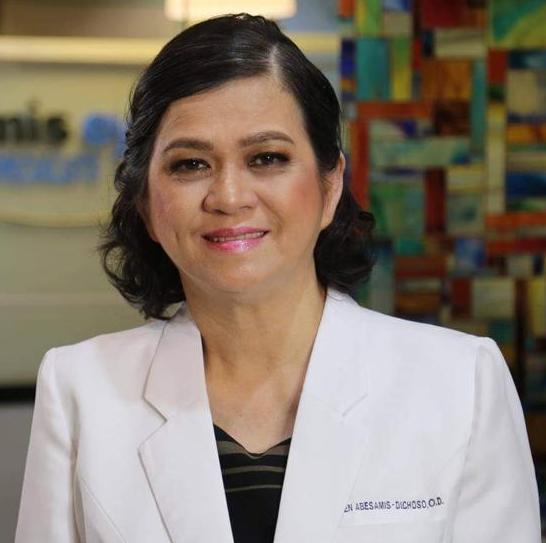In 2000, low to moderate myopia was prevalent in 20.2% or 1.243 billion people around the world. This figure is estimated to increase to 40% or 3.82 billion by 2050. Meanwhile, high myopia is expected to increase from 2.7% (or 163 million) to 9.8% (or 938 million) in the same time frame.
Further, the World Health Organization (WHO) World Report on Vision 2019 noted that 2.6 billion have myopia and of those, 312 million are under 19-years-old. In addition, one billion have no access to eye care — as eyeglasses are unaffordable or not accessible.
These statistics were revealed in a CooperVision webinar entitled Utilizing Multifocal Center Distance Soft Contact Lens in Myopia Management, presented by Dr. Carmen Abesamis-Dichoso.
Dr. Abesamis-Dichoso, an optometrist and eye care practitioner at Abesamis Eye Clinic in the Philippines, believes myopia is transforming from benign to a disease epidemic. Quoting the International Myopia Institute (IMI), she defines and classifies myopia with a proposed set of standards for clinical and epidemiologic studies.
She said that high myopia occurs when the refractive error is -6.00D or more when ocular accommodation is relaxed, and where pathologic myopia axial length is 26 mm or longer.
The Role of Sunlight in Myopia Control
Sunlight can explain the protective effect of outdoor activity against myopia, said Dr. Abesamis-Dichoso.
“For every one log unit increase in average daily light exposure, (which in the study equated to approximately 90 minutes or more of daily outdoor light exposure), the axial growth rate decreased by 0.12 mm/year (about 0.3 – 0.4 D slower myopia progression),” which was a result of a study in Australia.
Meanwhile, the Guangzhou Outdoor Activity Longitudinal (GOAL) study showed that 40 min/day of outdoor activity decreased myopia onset by 9% after three years. Another interventional study in Taiwan revealed that 80 min/day of intermittent outdoor time could decrease myopia onset up to 9% in only one year.
“A recent meta-analysis done by Shuyu Xiong et al. showed that with every additional one hour of outdoor time per week, the risk of myopia onset is reduced by 2% in children and adolescents,” said Dr. Abesamis-Dichoso.
This was further demonstrated by the Role of Outdoor Activity in Myopia (ROAM) study, which followed 101 children between 10 to 15 years of age, of whom 41 were myopic and 60 were non-myopic, from 42 Brisbane schools. Aussie kids generally spend more time outside than kids in many other countries, including Asian countries with a high incidence of myopia.
According to Stephen Vincent, OD, PhD, with the Queensland University of Technology, differences in daily outdoor light exposure may be one factor underlying the higher prevalence of myopia in Singapore. Singaporean students are exposed to 61 minutes of outdoor sun per day compared to 105 minutes for Australian children.
He concluded that bright light exposure for 60 minutes or less per day is a risk factor for faster eye growth, whereas daily outdoor light exposure of 60-90 minutes/day is likely to slow eye growth.
Li Deng, PhD, and her associates at the New England College of Optometry (NECO) Department of Vision Science also agreed that participating in more hours of sports and outdoor activities during the school year may protect against myopia development.
Controlling and Correcting Pathological Myopia
Myopia is found globally across ethnicities and its complications such as myopic maculopathy (MM), glaucoma, retinal detachment (RD) and cataract can be sight threatening, said Dr. Abesamis-Dichoso.
Pathological myopia is real and alive. A convincing case has been made that the delineation of physiological and pathological myopia is not valid, as the term “physiological” implies that there is a level of myopia that could be considered “safe” in comparison to emmetropia.
Using odds ratios, which describe the increased risk of a condition over a reference of one (this being the risk of emmetropia), it shows that even 1 D of myopia doubles the risk of MM and PSCC (posterior subcapsular cataract), and triples the risk of RD compared to the emmetrope. At 3D of myopia, the risk of PSCC triples, with the risk of RD and MM being nine times that of the emmetrope.
“We all know by this time that standard regular single vision glasses do not work,” said Dr. Abesamis-Dichoso. However, recent investigations suggest that undercorrection may enhance, rather than slow down, myopia progression in children, she added.
“Our findings support the hypothesis that myopes have an abnormal mechanism for detecting the direction of optical defocus of the retinal image. We suggest that this results in the stimulation of eye elongation when blur is present, rather than the expected inhibition of growth when the eye is myopic.
“We also conclude that the popular therapeutic strategy of under-correcting myopia in children maybe not only unwarranted but even potentially harmful,” she said.
A recent retrospective analysis of a private optometric practice’s clinical data further supports the notion that undercorrection results in greater myopia progression compared to full correction. Authors reported a significant positive correlation, with greater amounts of undercorrection resulting in greater myopic progression.
Another option is orthokeratology (also known as Ortho-K, OK or Overnight Vision Correction), which refers to the use of gas-permeable contact lenses that temporarily reshape the cornea to reduce refractive errors such as myopia, hyperopia and astigmatism.
According to Dr. Abesamis-Dichoso, overnight orthokeratology has shown to be effective in slowing myopia progression over a 12-year follow-up period and demonstrated a clinically acceptable safety profile.
The risk of microbial keratitis (MK) with overnight orthokeratology was similar to other overnight modalities. The risk of MK for daily disposable contact lenses is 2 in 10,000 wearers per year; for monthly disposable contact lenses, the rate is 12 in 10,000.
Dr. Abesamis-Dichoso also discussed the efficacy of various strategies to control myopia.
“The most efficient myopia control strategies are atropine, Ortho-K, multifocal contact lenses, prismatic bifocal lenses, peripheral addition lenses, and time spent outdoors.
“Refractive surgery is NOT effective, as well as single vision lenses and contact lenses, because these interventions only correct myopia — instead of controlling it,” she emphasized.
Meanwhile, accommodative and binocular vision (BV) conditions are about nine times more common than an ocular disease in patients aged 6 months to 18 years. Of these, approximately 20% have a binocular vision condition.
Slowing the Progress of Myopia with MFCL
She then described multifocal contact lenses (MFCL) with a 2.0 mm central distance zone and 2.0-5.0 mm increasing plus power across a 5.0 mm pupil, including Acuvue Oasys (Johnson & Johnson, Florida, USA); CooperVision MiSight (California, USA); CooperVision Biofinity; and Visioneering Technologies NaturalVue (Georgia, USA).
Dr. Abesamis-Dichoso detailed a study that found in 70% of the children, myopia progression was reduced by 30% or more in the eye wearing dual focus (DF) lens, relative to that wearing the single vision distance (SVD) lens in period one (10 months). Similar reductions in myopia progression and axial eye elongation were also observed with DF lens wear during period two (10 months further). Visual acuity and contrast sensitivity with DF lenses were not significantly different than with SVD lenses. Accommodation to a target at 40 cm was driven through the central distance-correction zone of the DF lens.
“Soft multifocal contact lenses with a distance center design may slow the average growth of the myopic eye, and some studies suggest that the treatment effect for axial elongation continues to accrue beyond the first year of treatment,” she said.
She then covered an August 2020 report published in JAMA that asked: Can soft multifocal contact lenses with high add power slow myopia progression in children more than medium add power or single-vision contact lenses?
The clinical trial found “that in children with myopia, treatment with high add multifocal contact lenses — compared with medium add multifocal and single-vision contact lenses — reduced the rate of myopia progression over three years (but further research is needed).” [Editor’s Note: See infographic on page 37]
Further, Dr. Abesamis-Dichoso said the ideal candidate for multifocal soft contact lenses (MFSCLs) should be mature, motivated, with parental support and myopia with low astigmatism, with very limited reusable soft multifocal toric options and no daily disposable multifocal toric option.
If the child is a suitable contact lens wearer, the contact lens options can be OK or MFSCLs OrthoK, Toric MFSCLs, or daily disposable MFSCLs. They should work with 50% efficacy, she concluded.
Editor’s Note: The CooperVision webinar took place on August 15, 2020. Reporting for this story is from information obtained from that webinar.



![iStock 1207202567 [Converted]_V2](https://cookiemagazine.org/wp-content/uploads/sites/6/2022/03/iStock-1207202567-Converted_V2-01-579x326.jpg)
